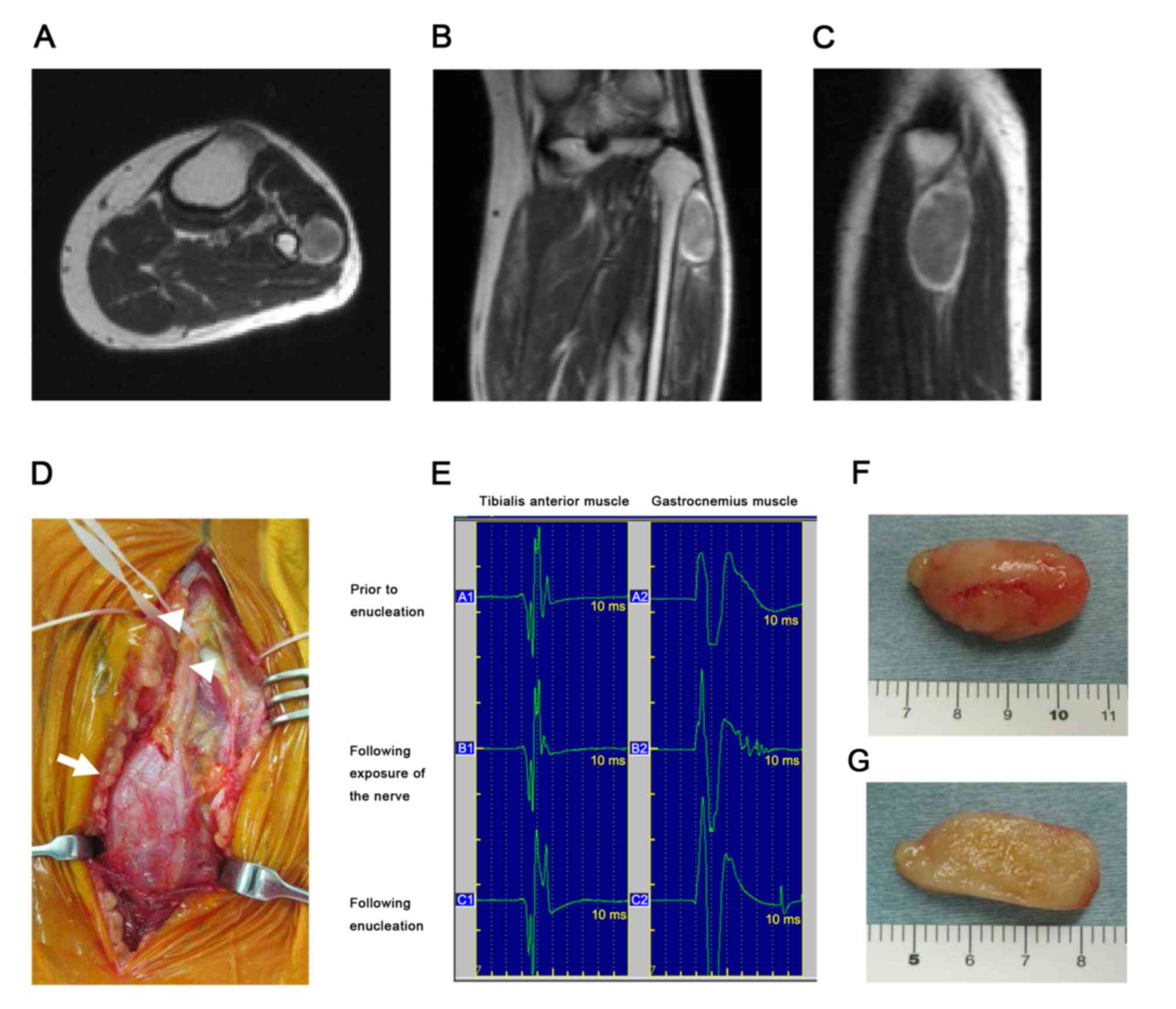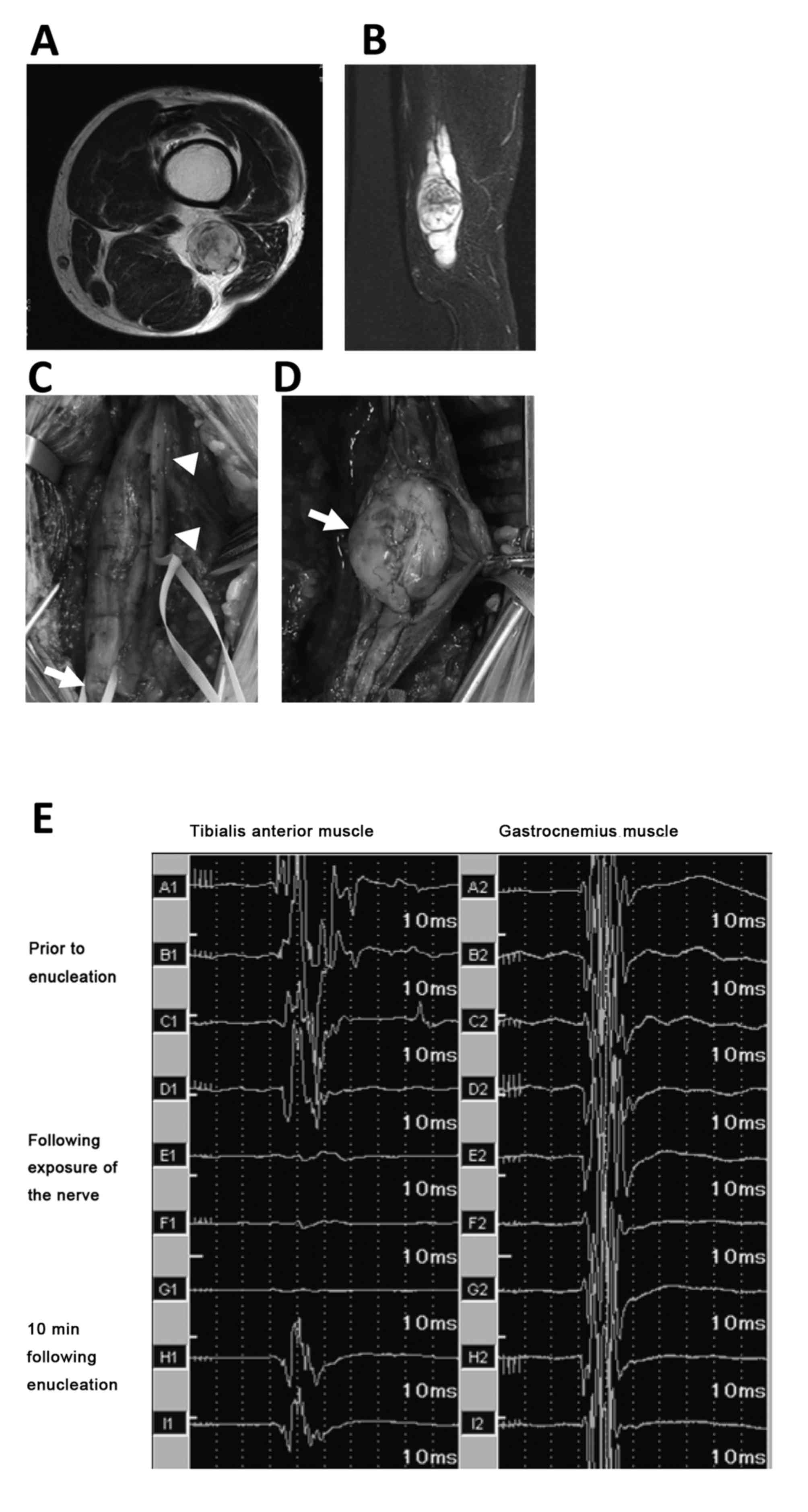|
1
|
Kransdorf MJ: Benign soft-tissue tumors in
a large referral population: Distribution of specific diagnoses by
age, sex, and location. AJR Am J Roentgenol. 164:395–402. 1995.
View Article : Google Scholar : PubMed/NCBI
|
|
2
|
Park MJ, Seo KN and Kang HJ: Neurological
deficit after surgical enucleation of schwannomas of the upper
limb. J Bone Joint Surg Br. 91:1482–1486. 2009. View Article : Google Scholar : PubMed/NCBI
|
|
3
|
Hyun SJ and Rhim SC: Combined motor and
somatosensory evoked potential monitoring for intramedullary spinal
cord tumor surgery: Correlation of clinical and neurophysiological
data in 17 consecutive procedures. Br J Neurosurg. 23:393–400.
2009. View Article : Google Scholar : PubMed/NCBI
|
|
4
|
Epstein NE: The need to add motor evoked
potential monitoring to somatosensory and electromyographic
monitoring in cervical spine surgery. Surg Neurol Int. 4 Suppl
5:S383–S391. 2013. View Article : Google Scholar : PubMed/NCBI
|
|
5
|
Feng B, Qiu G, Shen J, Zhang J, Tian Y, Li
S, Zhao H and Zhao Y: Impact of multimodal intraoperative
monitoring during surgery for spine deformity and potential risk
factors for neurological monitoring changes. J Spinal Disord Tech.
25:E108–E114. 2012. View Article : Google Scholar : PubMed/NCBI
|
|
6
|
Pastorelli F, Di Silvestre M, Plasmati R,
Michelucci R, Greggi T, Morigi A, Bacchin MR, Bonarelli S, Cioni A,
Vommaro F, et al: The prevention of neural complications in the
surgical treatment of scoliosis: The role of the neurophysiological
intraoperative monitoring. Eur Spine J. 20 Suppl 1:S105–S114. 2011.
View Article : Google Scholar : PubMed/NCBI
|
|
7
|
Artico M, Cervoni L, Wierzbicki V,
D'Andrea V and Nucci F: Benign neural sheath tumours of major
nerves: Characteristics in 119 surgical cases. Acta Neurochir
(Wien). 139:1108–1116. 1997. View Article : Google Scholar : PubMed/NCBI
|
|
8
|
Oberle J, Kahamba J and Richter HP:
Peripheral nerve schwannomas-an analysis of 16 patients. Acta
Neurochir (Wien). 139:949–953. 1997. View Article : Google Scholar : PubMed/NCBI
|
|
9
|
Donner TR, Voorhies RM and Kline DG:
Neural sheath tumors of major nerves. J Neurosurg. 81:362–373.
1994. View Article : Google Scholar : PubMed/NCBI
|
|
10
|
Sawada T, Sano M, Ogihara H, Omura T,
Miura K and Nagano A: The relationship between pre-operative
symptoms, operative findings and postoperative complications in
schwannomas. J Hand Surg Br. 31:629–634. 2006. View Article : Google Scholar : PubMed/NCBI
|
|
11
|
Kelleher MO, Tan G, Sarjeant R and
Fehlings MG: Predictive value of intraoperative neurophysiological
monitoring during cervical spine surgery: A prospective analysis of
1055 consecutive patients. J Neurosurg Spine. 8:215–221. 2008.
View Article : Google Scholar : PubMed/NCBI
|
|
12
|
Lenke LG, Newton PO, Sucato DJ,
Shufflebarger HL, Emans JB, Sponseller PD, Shah SA, Sides BA and
Blanke KM: Complications after 147 consecutive vertebral column
resections for severe pediatric spinal deformity: A multicenter
analysis. Spine (Phila Pa 1976). 38:119–132. 2013. View Article : Google Scholar : PubMed/NCBI
|
|
13
|
Hilibrand AS, Schwartz DM, Sethuraman V,
Vaccaro AR and Albert TJ: Comparison of transcranial electric motor
and somatosensory evoked potential monitoring during cervical spine
surgery. J Bone Joint Surg Am. 86-A:1248–1253. 2004. View Article : Google Scholar : PubMed/NCBI
|
|
14
|
Schwartz DM, Sestokas AK, Dormans JP,
Vaccaro AR, Hilibrand AS, Flynn JM, Li PM, Shah SA, Welch W,
Drummond DS and Albert TJ: Transcranial electric motor evoked
potential monitoring during spine surgery: Is it safe? Spine (Phila
Pa 1976). 36:1046–1049. 2011. View Article : Google Scholar : PubMed/NCBI
|
|
15
|
Kobayashi S, Matsuyama Y, Shinomiya K,
Kawabata S, Ando M, Kanchiku T, Saito T, Takahashi M, Ito Z,
Muramoto A, et al: A new alarm point of transcranial electrical
stimulation motor evoked potentials for intraoperative spinal cord
monitoring: A prospective multicenter study from the spinal cord
monitoring working group of the Japanese society for spine surgery
and related research. J Neurosurg Spine. 20:102–107. 2014.
View Article : Google Scholar : PubMed/NCBI
|
|
16
|
Jimenez JC, Sani S, Braverman B, Deutsch H
and Ratliff JK: Palsies of the fifth cervical nerve root after
cervical decompression: Prevention using continuous intraoperative
electromyography monitoring. J Neurosurg Spine. 3:92–97. 2005.
View Article : Google Scholar : PubMed/NCBI
|
|
17
|
Fan D, Schwartz DM, Vaccaro AR, Hilibrand
AS and Albert TJ: Intraoperative neurophysiologic detection of
iatrogenic C5 nerve root injury during laminectomy for cervical
compression myelopathy. Spine (Phila Pa 1976). 27:2499–2502. 2002.
View Article : Google Scholar : PubMed/NCBI
|
|
18
|
Bose B, Sestokas AK and Schwartz DM:
Neurophysiological detection of iatrogenic C-5 nerve deficit during
anterior cervical spinal surgery. J Neurosurg Spine. 6:381–385.
2007. View Article : Google Scholar : PubMed/NCBI
|
|
19
|
Bhalodia VM, Schwartz DM, Sestokas AK,
Bloomgarden G, Arkins T, Tomak P, Gorelick J, Wijesekera S, Beiner
J and Goodrich I: Efficacy of intraoperative monitoring of
transcranial electrical stimulation-induced motor evoked potentials
and spontaneous electromyography activity to identify acute-versus
delayed-onset C-5 nerve root palsy during cervical spine surgery:
Clinical article. J Neurosurg Spine. 19:395–402. 2013. View Article : Google Scholar : PubMed/NCBI
|
|
20
|
Kai Y, Owen JH, Allen BT, Dobras M and
Davis C: Relationship between evoked potentials and clinical status
in spinal cord ischemia. Spine (Phila Pa 1976). 20:291–296. 1995.
View Article : Google Scholar : PubMed/NCBI
|
|
21
|
Leppanen RE: Intraoperative monitoring of
segmental spinal nerve root function with free-run and
electrically-triggered electromyography and spinal cord function
with reflexes and F-responses. A position statement by the American
Society of Neurophysiological Monitoring. J Clin Monit Comput.
19:437–461. 2005. View Article : Google Scholar : PubMed/NCBI
|
















